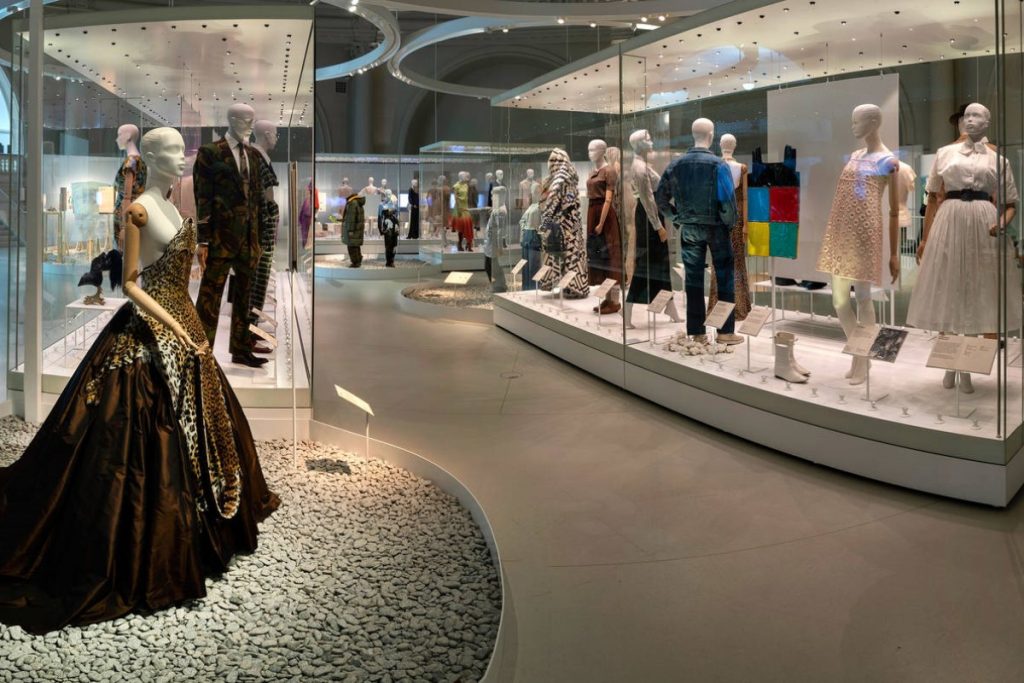Fashioned from Nature (Touring)
A pineapple fibre clutch-bag, Emma Watson’s Calvin Klein dress made from recycled plastic bottles and a cape of cockerel feathers are amongst the 300 beautiful, intriguing and unsettling objects from the V&A’s next major fashion exhibition.
Fashioned from Nature will trace the complex relationship between fashion and the natural world since 1600. It will show how fashionable dress recurringly draws on the beauty and power of nature for inspiration, with exquisite garments and accessories from Christian Dior, Dries van Noten and Philip Treacy. It will explore how fashion’s processes and constant demand for raw materials damage the environment, featuring campaigners and protest groups that have effectively highlighted this issue such as Fashion Revolution and Vivienne Westwood. It will also look at the role of design in creating a better, more sustainable fashion industry.
The exhibition will showcase contemporary designers of desirable, creative and sustainable popular fashion. Menswear and womenswear from Stella McCartney, known for a commitment to and success in developing new alternative sustainable materials, will be displayed alongside an upcycled dress by Christopher Raeburn. At the 2016 Met Gala, actor Emma Watson wore a Calvin Klein look made from recycled plastic bottles. With separate parts, it was intended to be re-worn in different ways. The look was created as part of the ‘Green Carpet Challenge’ with Eco-Age, an initiative to pair sustainability with glamour. It will be shown with a floral dress from Erdem’s Green Carpet Challenge collection.
Fashioned from Nature will draw attention to the use of innovative fabrics. Vegea use grape waste from the wine industry to form a leather-substitute and their Grape gown will be on show, as will a Ferragamo ensemble made from ‘Orange Fiber’ derived from waste from the Italian citrus industry and an H&M Conscious dress made from recycled shoreline plastic. The exhibition will look to the past 400 years of fashion to explore what we can learn from fashion practice in the past, with objects dating to the early 1600s. Items include an 1875 pair of earrings formed from the heads of two real Honeycreeper birds – a hugely popular item sold in enormous volume at the time – and a 1860s muslin dress decorated with the iridescent green wing cases of hundreds of jewel beetles. They will be shown alongside natural history specimens to indicate the ways fashion has used animal materials in its designs and production.
The natural world has always provided rich inspiration for beautiful fashion. This will be shown in displays of exquisite garments from the historic to the contemporary. They range from a 1780s man’s waistcoat, expertly embroidered with a pattern of playful Macacque monkeys, to Gucci’s contemporary bag decorated with stag beetle motifs. One of the earliest pieces in the exhibition, a women’s jacket from the early 1600s, is intricately embroidered with designs of pea-shoots and flowers. A 2016 Giles Deacon haute-couture dress features a pattern of delicate bird’s eggs, whilst gowns from Jean Paul Gaultier (1997) and Busvine (1933-4) both feature leopard print.
The exhibition will also focus closely on the raw materials used in the production of fashion. Arranged chronologically, it will introduce the main fibres used in the 17th and 18th centuries – silk, flax, wool and cotton – as well as now controversial materials like whalebone, demonstrated by an x-ray by Nick Veasey of a pair of 1780s stays, and turtle shell, used in a fan from 1700. It goes on to chart the expansion in international trade, import of precious materials, and later introduction of man-made materials, which brought fashionable dress to the masses but also contributed to the air and water pollution to which the textile industry is such a significant contributor.
A bold display of posters, slogan clothes and artworks will show how protest movements have helped draw attention to the harmful side of fashion. Figures like Vivienne Westwood have popularised these issues and a mannequin will pay homage to an outfit worn by her whilst protesting against climate change. A man’s outfit from Katharine Hamnett’s 1989 ‘Clean Up or Die’ collection will be on show alongside posters from Fashion Revolution, a collective aiming to change the way clothes are sourced, produced and consumed. Customising and re-wearing clothes will be highlighted through a vintage outfit and a jacket customised by London designer Katie Jones for fashion writer and editor Susie Lau to wear during Fashion Revolution Week 2015.
The exhibition will present a range of solutions to reducing fashion’s impact on the environment from low water denim and using wild rubber to more conceptual and collaborative projects. These include a dress grown from plant roots by the artist Diana Scherer, who uses seed, soil and water to train root systems into textile-like material, a bioluminescent genetically-engineered silk dress created by Sputniko!, the MIT Lab and the National Institute of Agricultural Science (NIAS), South Korea, and a tunic and trousers made from synthetic spider silk from Bolt Threads x Stella McCartney.
Centre for Sustainable Fashion (CSF) at London College of Fashion, UAL, will present two interactive installations which explore ‘Fashion Now’ and ‘Fashion Future.’ ‘Fashion Now’ will take five iconic contemporary fashion pieces and using sensors, visitors will be able to explore the unseen impact on nature of the construction, making, wearing and discarding of each item. ‘Fashion Future’ will immerse viewers into the fashion world of the future, inviting us to question what fashion means and show us a future we are yet to imagine.
Touring:
V&A Museum, London, 21 April 2018 – 27 January 2019
Natural History Museum of Denmark, Copenhagen,13 April – 1 September 2019
Image © Victoria and Albert Museum, London
